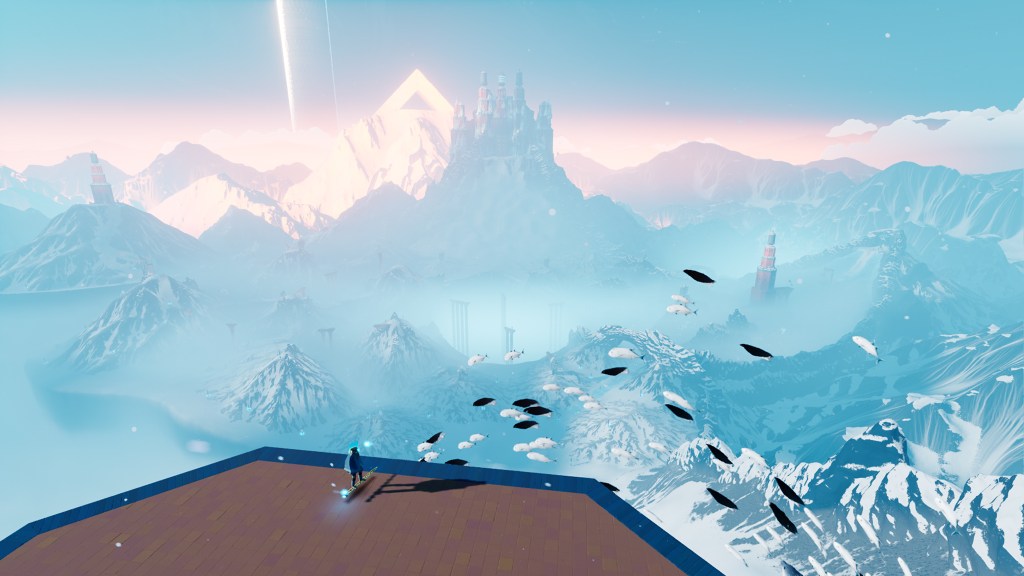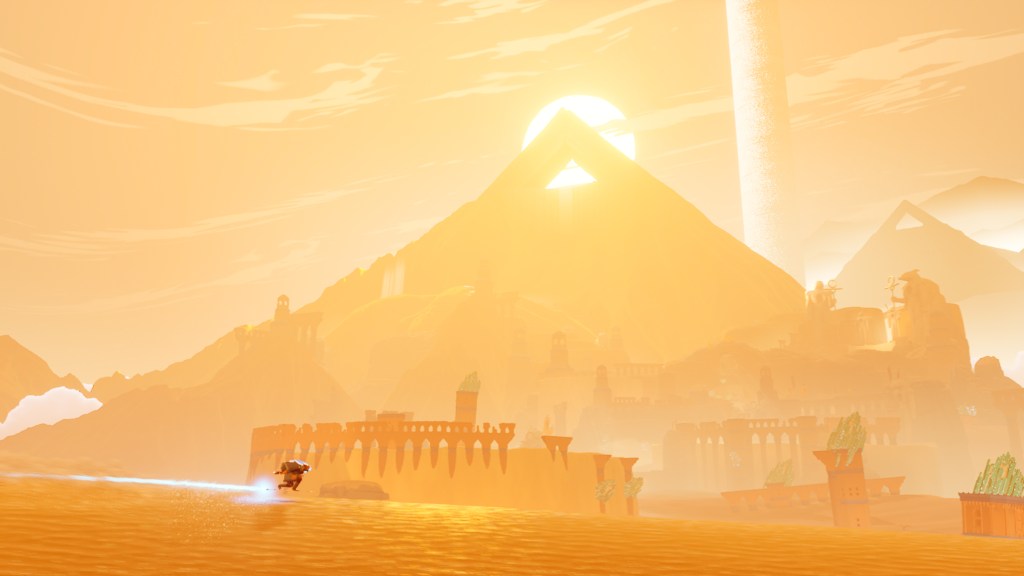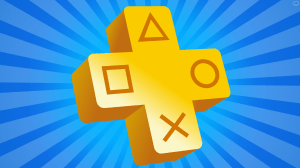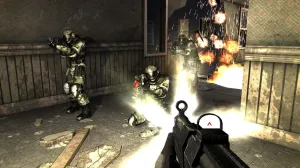The buster sword. Rebellion. Stygius. All of these are blades legendary for their proficiency for killing, be it Shinra goons, demons, or Hades’ forces. They’re technically tools, but tools of violence and destruction.
Videos by ComicBook.com
That’s not the case with the titular sword in Sword of the Sea. This armament is almost exclusively used as a method of traversal, like Tony Hawk and his Birdhouse deck if the latter were sharp, twice as long, and hovered above the ground. It’s a unique approach, but one that combines wonderfully with developer Giant Squid’s impeccable and signature art direction to create a thoroughly mesmerizing experience.
Sword of the Sea’s ability to instantly mesmerize stems from its brilliant audiovisual presentation. Its direct lineage to Journey is apparent, given how both are covered in a sparkly sheen with a similar color palette, but that doesn’t make what Giant Squid was able to do with Sword of the Sea any less impressive. There’s a painterly quality to the game’s world that’s dominated by bold colors, all of which give Sword of the Sea an attractive, saturated look regardless of how waterlogged each terrain is. Unleashing the emerald sea — a common goal within the game — drenches the landscape in softer blues and greens, but that doesn’t overshadow how gorgeous its desert and frozen biomes are; the core art style is just that strong.
A Visual Stunner

The vistas highlight everything beautiful about the game, and are presented with an astonishing level of earned confidence. Sword of the Sea often puts players in some tunnels where the light or a tall hill obscures what lies beyond, only to reveal the most striking and densely detailed horizon and a swelling soundtrack once players pass a certain threshold. It’s a staggering reveal every time that not only once again demonstrates the killer art, but illustrates how presentation of that art is important for showcasing it in the best way possible.
Sword of the Sea stuns in static screenshots because of this style, but sings in motion. Dunes undulate to mimic waves. Schools of fish flutter about in the sky, sometimes joined by various larger creatures like whales or dolphins. While the civilizations that lived in this universe have been buried beneath sand and time, Sword of the Sea livens up this setting through subdued motion that makes everything feel like an animated painting.
This translates to player movement, too, since the game utilizes traversal during its best moments. Some of these are scripted set pieces where the music builds as players jet down a hill or ride on top of a giant creature, and while these are enrapturing scenes that recall some of the most memorable parts of Abzu and Journey, Sword of the Sea better integrates them into the experience through the Hoversword. This floating, rideable blade is a kinetic way to get around and empowers players to bolt around and catch big air, all while flipping and performing tricks on the way down.
Since boarding around is the core mechanic, players can bomb down frozen mountains and flip around without needing to wait for a set piece’s permission. While there are more curated scenes that are thrilling rollercoasters, being able to fool around and organically create adrenaline-fueled combos speaks to the power of having such a slick movement system in a vibes-based game like this.
Hitting a Small Bit of Turbulence

Even though it nails the basic feeling of surfing about, as well as the little details like appropriately subtle DualSense haptics and the visual effects that highlight the player’s speed, Sword of the Sea does not always elegantly weave those elements together smoothly. Players can spend currency on new tricks and moves, but not even the most meticulous collectors can buy more than half of them before the credits roll. They also get prohibitively more expensive each time, meaning it will likely take multiple New Game Plus runs to get every one. And Sword of the Sea — unlike the seamless open world seen in Giant Squid’s previous game, The Pathless — strangely restricts players from backtracking to pick up extra currency and collectibles. A post-game chapter select feature doesn’t change how this current system is an artificial way to force replayability.
A game with a more elaborate trick system that invites mastery may be able to get away with this run-based setup, but Sword of the Sea’s tricks are simple button presses and not the fighting game-esque combos seen in Tony Hawk’s Pro Skater. It keeps track of the player’s score, yet does nothing with it; it’s a mere meaningless number in the pause screen. Not even the handful of score-based challenge rooms stretch out its mechanics since each one has an insultingly low high score that can often be cleared in 15 seconds. Given the futility of the score system and the disappointing dearth of currency, it would seemingly make more sense if players were given credits for doing tricks. Without a thread to bind these spotty systems together, they both suffer.
While a more fleshed-out and better integrated trick system would have benefited Sword of the Sea, it is still sharp enough without it. Barreling down a sandy ravine near a massive dolphin while Austin Wintory’s lovely score plays is engaging on multiple levels. It’s visually pleasing enough to succeed on its atmospheric merits while also being mechanically rewarding due to its smooth, speed-based snowboarding-esque systems. A soothing game with exciting gameplay is an odd match but a pairing that works well, much like a sword that’s been turned into a hoverboard.
Rating: 4 out of 5
A review copy for PS5 was provided by the publisher for the purpose of this review.









